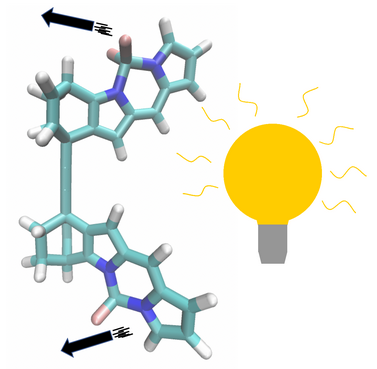Jun 18 2021
Light-driven molecular motors have been in existence for more than two decades, and they usually take a microsecond to nanoseconds for a single revolution.
 Upon simultaneous excitation of the two chromophores by light, they repel each other through dipolar interactions. As the chromophores are bound to each other they start rotating about the bond keeping them together. Image Credit: Thomas Jansen.
Upon simultaneous excitation of the two chromophores by light, they repel each other through dipolar interactions. As the chromophores are bound to each other they start rotating about the bond keeping them together. Image Credit: Thomas Jansen.
Thomas Jansen, an associate professor of physics from the University of Groningen, and Atreya Mujumdar, a Master’s student, have now developed an even faster molecular motor. The novel design is driven only by light and, using the power of just one photon, can make a full turn in picoseconds.
We have developed a new out-of-the-box design for a motor molecule that is much faster.
Thomas Jansen, Associate Professor of Physics, University of Groningen
The design was published in The Journal of Physical Chemical Letters on June 7th, 2021.
The advanced motor design began with a project in which Jansen intended to figure out the energy landscape of the excited chromophores.
These chromophores can attract or repel each other. I wondered if we could use this to make them do something.
Thomas Jansen, Associate Professor of Physics, University of Groningen
Jansen later handed the project to Majumdar, who was a first-year student in the Top Master’s degree program in Nanoscience at Groningen at the time. Majumdar replicated the interaction between a pair of chromophores that were linked together to create a single molecule.
Light
Majumdar, now a PhD student in Nanoscience at the Université Paris-Saclay in France, explained his finding, “A single photon will excite both chromophores simultaneously, creating dipoles that make them repel each other.”
However, since they are stuck together, linked by a triple bond axis, the two halves tend to push each other away around the axis.
“During this movement, they start to attract each other,” added Majumdar.
This collectively leads to a full rotation, produced by the light energy and the electrostatic interaction between the pair of chromophores.
The actual light-driven molecular motor was designed by Jansen’s collaborator, Ben Feringa, Professor of Organic Chemistry at the University of Groningen, and the winner of the 2016 Nobel Prize for Chemistry. The light-driven molecular motor makes a single revolution in four steps.
The heat steps are rate-limiting. The molecule has to wait for a fluctuation in heat energy to drive it to the next step.
Thomas Jansen, Associate Professor of Physics, University of Groningen
Bottleneck
On the contrary, in the latest design, the rotation is purely downhill from an excited state. According to quantum dynamics, since a single photon can excite two chromophores at the same time, there are no significant bottlenecks to restrict the rotation speed. This rotation is two to three orders of magnitude higher than that of the traditional “Feringa” motors. All of these findings are still theoretical, based on simulations and calculations.
“Building one of these motors is not trivial,” added Jansen.
The chromophores are extensively used but they are fragile, making it hard to create a triple bond. According to Jansen, since the properties of this organic molecule have been explained, someone will try to design it. It is not just one particular molecule that has these properties, “We have created a general guide for the design of this type of molecular motor,” added Majumdar.
Blueprint
Jansen can think of a handful of applications. For example, the motors can be used to move nanoscale objects on a surface, power drug delivery, or they could be even used in other nanotech applications. Since the rotational speed is higher than that of the average biophysical process, it could be used to regulate biological processes. During the simulations, the motors were fixed to the surface but they are also capable of rotating in solution.
“It will require a lot of engineering and tweaking to realize these motors but our blueprint will deliver a brand-new type of molecular motor,” concluded Jansen.
Journal Reference:
Majumdar, A & Jansen, T L C (2021) Quantum-Classical Simulation of Molecular Motors Driven Only by Light. The Journal of Physical Chemistry Letters. doi.org/10.1021/acs.jpclett.1c0095.